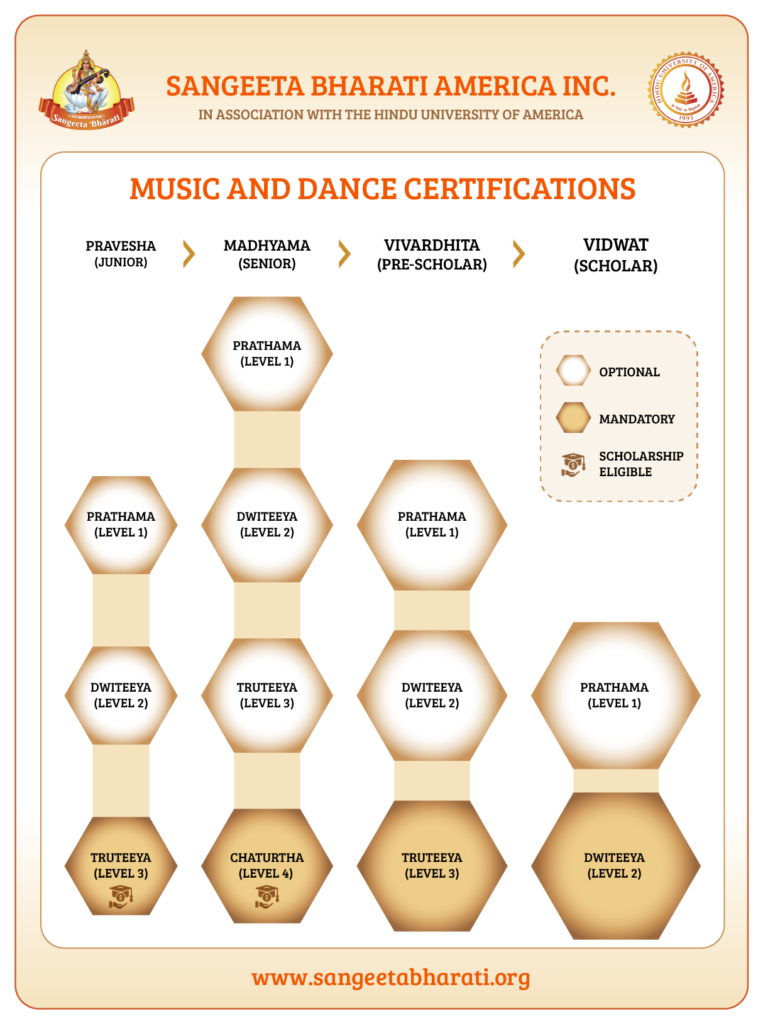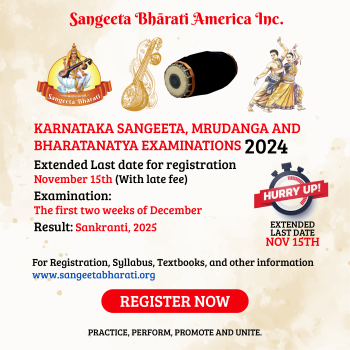Examinations and Contests
Bharateeya Sangeeta (Indian music) and the Nrutya (dance) are performing art forms. The practice levels are best judged by the practitioners themselves. In the “Gurukul” system, a disciple of music or dance continuously follows and learns from the Guru. In that sense, certifications or examinations do not matter, as the Guru and the disciple are fully aware of the disciple’s level of accomplishments and skills. Sangeeta Bharati encourages music and dance aspirants to focus on learning and continuing the tradition of the Gurukul system in the way it has been followed through generations.
With changes in time and circumstances, if someone wants to take an examination as a means of quantitatively assessing his or her level of accomplishment, Sangeeta Bharati has designed a well-thought evaluation process.
Karnataka Sangeeta, Mrudanga and Bharatanatya Examinations
Exam Registration for the Year 2024 is open now. The extended last date for registration is 15 November 2024. Please hurry up!
Why examination?
It is necessary to have a goal set and evaluated by an independent and competitive authority to assess proficiency from time to time. This holistic and structured approach has its benefits.
1. Examination motivates one to have a goal, stay focused, and practice to achieve that goal.
2. The examination will help the student to know their strengths and weaknesses with a standpoint of themselves compared to others and mirror one’s knowledge and areas of improvement as necessary.
3. Successful completion of the examinations at different levels makes sure a student knows all aspects of music set for a given level.
4. Completing examinations progressively and thereby moving into higher-up exams will have measurable learning and instill confidence.
5. Examinations will instill a sense of achievement in students.
6. For Gurus, it is a great way to reward their students for completing their course.
Similarly, contests are for younger populations who are not yet into formal learning, and can’t voluntarily recognize the value of an art form but can be motivated with recognitions and prizes.

The certification program is planned for the students of Hindustani and Karnataka Sangeeta as well as different dance forms like Bharatanatyam, Kuchipudi, and Kathak. Under this program, students may seek certification in four major levels of proficiency.
A prerequisite for each level is to have passed the prior major level. A student becomes eligible to receive certification at a particular level by completing the corresponding practical, written, aural, and other tests conducted by the Sangeeta Bharati America.
Below are the Sangeeta Bharati examination levels. Each level is subdivided into three intermediary levels – Prathama, Dwiteeya, and Truteeya with the first two being optional. This total of twelve levels corresponds to twelve years of learning, a typical learning span for any Bharatiya Vidya.
Karnataka Sangeeta
1. Karnataka Sangeeta Pravesha (प्रवेश)
2. Karnataka Sangeeta Madhyama (मध्यम)
3. Karnataka Sangeeta Vivardhita (विवर्धित) and
4. Karnataka Sangeeta Vidwat (विद्वत्)
At Sangeeta Pravesha level (a beginner level), a music student is introduced to Karnataka music through simple music lessons like making one comfortable with the musical vocabulary, different musical compositions, and composers. Rendering a composition to Shruti and Tala is taught. This category is characterized by learning the Karnataka compositions up to Gamakam. The syllabus and examination pattern will lay out the expectations for each level.
With 30 to 45 minutes of practice each day, one can complete Pravesha in an average of three years.
A Sangeeta Madhyama (a senior) level is characterized by the comfortable use of Gamakams in renditions with an introduction to manodharma.
Vivardhita is characterized by manodharma sangeeta and preparation for Vidwat. Vidwat is performing/ practitioner and knowledge transfer level. Here, a musician will be evaluated with his peers.
Karnataka Talavadya
1. Karnataka Talavadya Pravesha (प्रवेश)
2. Karnataka Talavadya Madhyama (मध्यम)
3. Karnataka Talavadya Vivardhita (विवर्धित) and
4. Karnataka Talavadya Vidwat (विद्वत्)
1. Each category has subcategories – Prathama, Dwiteeya, Truteeya, etc.,
2. The syllabus is not progressive. Instead, it is cumulative. Saying that Prathama syllabus is included in Dwiteeya, Dwiteeya syllabus (which also has Prathama portion) is included in Truteeya.
3. For those taking Dwiteeya, it has a syllabus from Prathama. Similarly, those taking Truteeya, will have a syllabus from Prathama and Dwiteeya included.
4. Prathama and Dwiteeya are only at an evolution level which helps a student to see where they stand in practice. Truteeya is the certification level where a certificate is awarded.
5. Based on a student’s preparedness, he/she can choose any level or Prathama to Truteeya in progression.
Bharatanatya
1. Bharatanatya Pravesha (प्रवेश)
2. Bharatanatya Madhyama (मध्यम)
3. Bharatanatya Vivardhita (विवर्धित) and
4. Bharatanatya Vidwat (विद्वत्
With the support from the students and fraternity of Indian fine arts, we gradually expanded it to other levels of Karnataka Sangeeta and Talavadya as well as Hindustani music and the various dance forms of India. When conducted, Hindustani Sangeeta and Nrutya (dance) will have similar certification levels. E..g, Hindustani Pravesha.
Currently Offered Examinations and Contests
Karnataka Sangeeta Pravesha and Madhyama
Junior level certification in Karnataka music and percussion
Karnataka Talavadya Pravesha and Madhyama
Senior level certification in Karnataka music and percussion
Bharatanatya Pravesha
Junior level certification in Bharatanatya type of dance
Timeline
Registration: From Ganesh Chaturthi to Vijayadashami
Registration with late fee: Until November 15th
Exams: 1st and 2nd weeks of December (1st and 2nd weekends for in-person)
Result: Sankranti, the following year
Convocation: The following year on Vijayadashami day during Navaratri Sangeetotsav
To take an exam conducted by Sangeeta Bharati, one should have learned from his or her Guru. Once they are ready, they can appear for the examination. The Sangeeta Bharati syllabus is detailed and it requires a significant commitment of time and effort for someone to prepare. Hence, it has “levels” and not “years”.
Becoming an accomplished musician or a dancer is a long process and it takes around 20 years after the student starts the learning process. Still, our syllabus reflects the standard learning timeframe for Indian art which is 12 years to reach the performer level, starting from an elementary level. So learn thoroughly from your Guru, practice, and prepare yourself well before taking the examination.
Examination Grades
Range | Category | Grade |
90% – 100% | Distinction | A+ |
80% – 89% | First Class | A |
70% – 79% | Second Class | B |
50% – 69% | Pass | C |
Below 50% in any subject | Appeared, but failed. | F |
Pravesha (Junior) Examination Fees
(Being an encouraging level, the fee is structured to gradually increase if one opts to attend each level)
Pravesha Exams | Fees |
Prathama (Level 1) | $101 |
Dwiteeya (Level 2) | $201 (For those who attended Prathama) |
$301 (For all others) | |
Truteeya (Level 3) (It is a certification level. The level Truteeya is also called Sangeeta Pravesha/Talavadya Pravesha) | $301 (For those who attended Dwiteeya) |
$401 (For those who attended Prathama alone) | |
$501 (For all others) |
Madhyama (Senior) Examination Fees
(Equally distributed fee structure if one opts to attend each level)
Madhyama Exams | Fees |
Prathama (Level 1) | $301 |
Dwiteeya (Level 2) | $301 (For those attended Prathama) |
$601 (For all others) | |
Truteeya (Level 3) | $301 (For those who attended Dwiteeya) |
$601 (For those who attended Prathama alone) | |
$901 (For all others) | |
Chaturtha (Level 4) | $301 (For those who attended Truteeya) |
$601 (For those who attended Dwiteeya) | |
$901 (For those who attended Prathama alone) | |
$1201 (For all others) |
FAQs
1. Sangeeta Bharati provides free practice materials through its publication (https://www.sangeetabharati.org/). It is not necessary to use Sangeeta Bharati materials and students are free to choose practice and study materials on their own or rely solely on the materials provided by their gurus.
2. The terms like “Vaggeyakara”, and “Raga” have no equivalent English words though words like “composer” and “scale” are inevitably used. For this reason, though not mandatory, we encourage the use of native terms which are predominantly in Sanskrit.
3. Adults who have spent a good amount of time practicing music or dance and demonstrated their skill but have not taken any examinations can skip junior levels (including those marked mandatory) and appear at the level that best suits them. This requires a recommendation from their Guru, completing preclearance test, and approved by the head of respective departments of Sangeeta Bharati.

